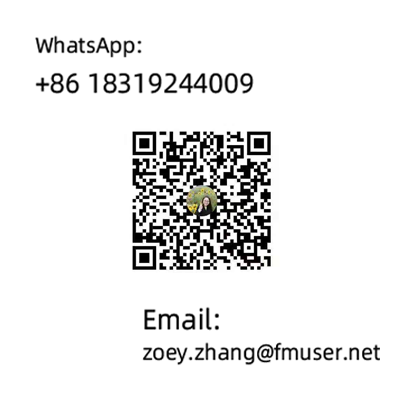Products Category
- FM Transmitter
- 0-50w 50w-1000w 2kw-10kw 10kw+
- TV Transmitter
- 0-50w 50-1kw 2kw-10kw
- FM Antenna
- TV Antenna
- Antenna Accessory
- Cable Connector Power Splitter Dummy Load
- RF Transistor
- Power Supply
- Audio Equipments
- DTV Front End Equipment
- Link System
- STL system Microwave Link system
- FM Radio
- Power Meter
- Other Products
- Special for Coronavirus
Products Tags
Fmuser Sites
- es.fmuser.net
- it.fmuser.net
- fr.fmuser.net
- de.fmuser.net
- af.fmuser.net ->Afrikaans
- sq.fmuser.net ->Albanian
- ar.fmuser.net ->Arabic
- hy.fmuser.net ->Armenian
- az.fmuser.net ->Azerbaijani
- eu.fmuser.net ->Basque
- be.fmuser.net ->Belarusian
- bg.fmuser.net ->Bulgarian
- ca.fmuser.net ->Catalan
- zh-CN.fmuser.net ->Chinese (Simplified)
- zh-TW.fmuser.net ->Chinese (Traditional)
- hr.fmuser.net ->Croatian
- cs.fmuser.net ->Czech
- da.fmuser.net ->Danish
- nl.fmuser.net ->Dutch
- et.fmuser.net ->Estonian
- tl.fmuser.net ->Filipino
- fi.fmuser.net ->Finnish
- fr.fmuser.net ->French
- gl.fmuser.net ->Galician
- ka.fmuser.net ->Georgian
- de.fmuser.net ->German
- el.fmuser.net ->Greek
- ht.fmuser.net ->Haitian Creole
- iw.fmuser.net ->Hebrew
- hi.fmuser.net ->Hindi
- hu.fmuser.net ->Hungarian
- is.fmuser.net ->Icelandic
- id.fmuser.net ->Indonesian
- ga.fmuser.net ->Irish
- it.fmuser.net ->Italian
- ja.fmuser.net ->Japanese
- ko.fmuser.net ->Korean
- lv.fmuser.net ->Latvian
- lt.fmuser.net ->Lithuanian
- mk.fmuser.net ->Macedonian
- ms.fmuser.net ->Malay
- mt.fmuser.net ->Maltese
- no.fmuser.net ->Norwegian
- fa.fmuser.net ->Persian
- pl.fmuser.net ->Polish
- pt.fmuser.net ->Portuguese
- ro.fmuser.net ->Romanian
- ru.fmuser.net ->Russian
- sr.fmuser.net ->Serbian
- sk.fmuser.net ->Slovak
- sl.fmuser.net ->Slovenian
- es.fmuser.net ->Spanish
- sw.fmuser.net ->Swahili
- sv.fmuser.net ->Swedish
- th.fmuser.net ->Thai
- tr.fmuser.net ->Turkish
- uk.fmuser.net ->Ukrainian
- ur.fmuser.net ->Urdu
- vi.fmuser.net ->Vietnamese
- cy.fmuser.net ->Welsh
- yi.fmuser.net ->Yiddish
Exploring the Radio Frequency Spectrum
Have you ever wondered what the numbers on your FM radio mean? Have you wondered what you could hear if you could somehow make your radio go lower than the lowest number (87.5) or higher than the highest number (108.0)? The numbers on your radio’s digital display stand for the radio frequencies that it is capable of receiving. For FM radio stations, these are measured in millions of cycles per second (MHz). In a similar way AM stations broadcast on frequencies measures in thousands of cycles per second (kHz). The most common AM radios sold today (in the U.S.) receive radio stations broadcasting on frequencies ranging from 520 to 1610 kHz.
Why are such odd numbers used for radio broadcasts? Radio waves are a form of electromagnetic radiation. Essentially, radio waves are the same as light waves; they’re just a different frequency. Electromagnetic radiation also includes infrared, ultraviolet, x-rays, gamma-rays, and cosmic-rays, with the difference between them being the frequencies at which they occur. To get the most use out of the frequencies physically available for radio transmissions, years ago the world’s governments divided up the radio spectrum, agreeing (for the most part) on which frequencies would be used for which applications. The numbers that you see on your radio display are the result of this division.
A typical AM radio receives signals in what has been designated the medium wave frequency band. (Electromagnetic radiation is measured in two ways: the length of the waves, or cycles, and the frequency of these waves, or how many cycles there are per second. Wavelength and frequency are inversely proportional. In other words, as the frequency increases the wavelength decreases and as the frequency decreases the wavelength increases.) This brings us to the point of the discussion. What could you hear if you could somehow tune your radio to frequencies lower or higher than what your radio shows?
The frequencies just below the lowest frequency on your AM radio are known as the long wave band. In Europe, Oceania, Africa, and parts of Asia these are used for commercial radio broadcasts, just like "normal" AM radio. In the United States, Canada, Bermuda, and U.S. territories, these are used mostly for aeronautical communication. The frequencies just above the highest station on your AM radio are divided into fifteen shortwave broadcast bands. Like typical AM and FM frequencies, these are used to broadcast commercial programs of news, music, etc. Unlike their AM and FM counterparts, shortwave transmissions are intended to be heard over great distances. Perhaps because of this, the shortwave bands are also home to one of the biggest mysteries in the world of amateur radio, number stations. These are illegal stations that can be heard in many parts of the world broadcasting a list of numbers, usually in a woman’s voice. Various languages and frequencies are used and the numbers are usually grouped as blocks of digits. While no government has acknowledged operating a number station, it is commonly believed that these are connected with the intelligence community and that the numbers represent encoded messages employing either the one-time pad system or a variation of the dictionary code system.
Other frequency bands are used for television broadcasts, cellular phone service, emergency services, maritime communication, satellite communication, space operations, radio navigation, radio location, meteorological aids, radio astronomy, and of course amateur radio transmissions. Would you like to listen to some of these transmissions? High quality shortwave receivers are readily available in electronics stores or over the internet. Radio scanners are also available for various frequencies and modulation methods (AM, FM, SSB). So with the right equipment it’s possible to listen, but it’s not always legal. For example, in the United States it is illegal for an unauthorized third party to listen to cellular or cordless phone calls. In the UK, it is illegal to listen to any transmission for which you are not the intended recipient. Other countries have different laws, so it’s good to know what the law is where you live.
People are talking all around you. Policemen, firemen, aircraft pilots, fishing boat captains, astronauts, apparently even spies are sending their voices into the ether. Why not get a shortwave radio or, if it’s legal, a radio scanner and hear what they’re saying? Like many others, perhaps you will find that exploring the vast radio spectrum beyond the boundaries of the AM and FM bands makes a fascinating hobby.

